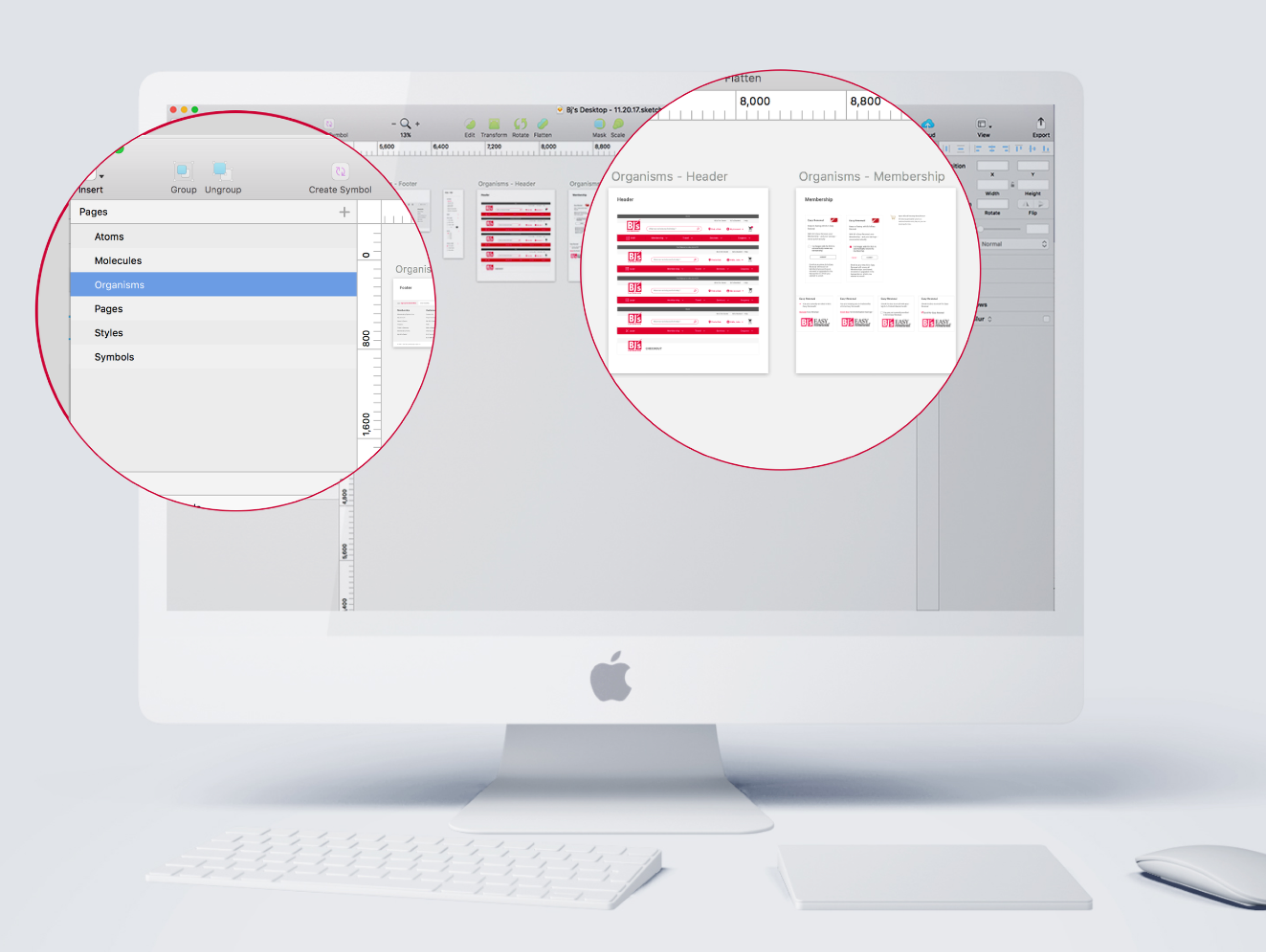BJ's Wholesale
Unified Design System & Scalable Governance
Business Objective
BJ's Wholesale Club aimed to create a unified design system to drive consistency, efficiency, and scalability across its digital ecosystem. With the transition to a modular framework using Angular on the IBM WebSphere eCommerce platform, a standardized design approach was essential to enhance UX and streamline development processes.
My Role
I set the foundation for the Global Atomic Design System, defining governance processes and ensuring that design components were systematically structured and reusable across BJ’s eCommerce platform. My role encompassed: Establishing the Framework & Process, Overseeing Execution, and Ensuring Alignment & Delivery.
This was a highly collaborative internal initiative, executed by BJ’s in-house design team. Given the tools available at the time, we leveraged Sketch as our primary design tool, maintaining a master governance system on BJ’s internal servers. As the lead, I was responsible for publishing design updates, which cascaded across all work streams within the Global Design Team. This structure ensured that each POD—responsible for distinct areas of BJ’s Wholesale eCommerce experience—remained aligned with a unified design language.
By centralizing governance and execution under a structured design system, we successfully streamlined workflows, improved efficiency, and set a foundation for scalable growth within BJ’s evolving digital ecosystem.
Problem
BJ’s UX team faced significant challenges in maintaining design consistency across digital touchpoints. Key issues included:
Inconsistent Design Across Platforms: Lack of a unified component library led to fragmented user experiences.
Misalignment with Development: Developers lacked a single source of truth for reusable components.
Inefficient Design Workflows: High-fidelity wireframing and handoff processes were time-consuming.
Absence of Governance & Documentation: No formalized process for maintaining and evolving design standards.
Impact
The absence of a unified design system resulted in:
Longer Design & Development Cycles: Inconsistent components led to redundant work.
Scalability Challenges: Without standardization, scaling new features required additional resources.
Decreased Cross-Team Efficiency: Misalignment between UX and engineering teams slowed project timelines.
Countermeasure
Solution Approach
To address these challenges, BJ’s implemented a Global Atomic Design System, aligned with Brad Frost’s Atomic Design methodology. Key actions included:
Establishing a Scalable Atomic Design System: Created a structured component library supporting both desktop and mobile breakpoints.
Aligning UX & Development Workflows: Defined shared design principles and collaboration processes.
Improving Efficiency & Consistency: Standardized UI components to accelerate design and development workflows.
Implementing Governance & Maintenance Processes: Introduced version control, documentation, and ongoing iteration protocols.
Execution
Research & Discovery:
Conducted a design audit to identify inconsistencies.
Analyzed best practices in atomic design for scalability.
Gathered stakeholder insights to align design and engineering goals.
Strategy & Ideation:
Defined foundational design principles.
Mapped out a scalable component hierarchy.
Established a collaborative workflow for UX and engineering teams.
Design & Implementation:
Developed a Sketch-based component library (Tool used during this time)
Ensured responsive design compatibility.
Created a Confluence repository with documentation and usage guidelines.
Collaboration & Governance:
Conducted design system workshops for team adoption.
Aligned component development with Angular framework.
Partnered with BJ’s QA teams to validate system functionality.
Testing & Iteration:
Conducted usability testing to refine components.
Conducted internal ‘stretch test’ with internal design team.
Iterated based on feedback from internal teams and end-users.
Results
Quantitative Impact
40% Reduction in Design & Development Time: Standardized components improved efficiency.
50% Increase in Design Consistency: Unified components enhanced UX across digital properties.
30% Decrease in Iteration Cycles: Improved collaboration minimized rework.
Higher Adoption Rates: UX and engineering teams fully integrated the design system into workflows.
Qualitative Impact
Enhanced UX & Engineering Collaboration: Established a shared design language.
Improved Developer Efficiency: Reusable components streamlined the build process.
Scalability for Future Enhancements: The system enabled seamless expansion.
Conclusion
BJ’s Global Atomic Design System successfully standardized UX across its digital ecosystem, improving efficiency, collaboration, and scalability. By integrating atomic design principles, aligning with development, and establishing governance, the initiative ensured a consistent and high-quality user experience.
Next Steps
Expand the design system to support additional platforms and use cases.
Enhance governance models to facilitate continuous iteration.
Introduce real-time analytics to measure design system adoption and effectiveness.

